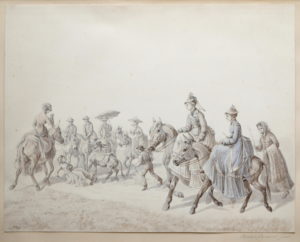Prestel, Therese (1856-1921)
Elise Dorothea Leonore Therese, Prestel (1856-1921), came from the well-known family of artists and publishers Prestel. Therese took her artistic family roots into account in the medium of the paper cutting technique, which was particularly popular in the 19th century. In these hand-sized humorous works, she took up themes from the time shortly after 1900 and skilfully illustrated the society of the 1910s to 1920s in Mainz, Wiesbaden, and Frankfurt. She was the daughter of Anna Britz and the sculptor and painter Johann Erdmann Gottlieb Prestel. Her great-grandfather was the painter and engraver Johann Gottlieb Prestel (1739-1808) and her great-grandmother the engraver and watercolour painter Maria Katharina Prestel (1747-1794).
The Silhouettes of Therese Prestel
Women's fashion played a special role in the period around the First World War. Equipped with their elaborate hats, bags, umbrellas and sticks and accompanied by the obligatory dog, the ladies stroll across the paper. In short, finely pencilled notes, Prestel noted the respective event, which was caricatured as a silhouette: from walks in the Frankfurt Palmengarten, to hikes in the Taunus to the Mainz rifle festival. The cut figures not only document the fashion and taste of the time in a humorous way, but they also offer an insight into Prestel's life as a lady of society. In her cuts, she also takes up politically explosive topics such as the World War itself or the Reichstag elections of the still young Weimar Republic.
While many of the collage-like works on paper were sent to friends and acquaintances, the Landesmuseum Mainz has preserved an inventory of around 300 sheets of paper cuts by the artist, which held its first exhibition of her works in the field of paper cutting technology, on the 15th of March to the 6th of June 2022. The artist often abbreviates her signature to “Th.P.”
Showing the single result
